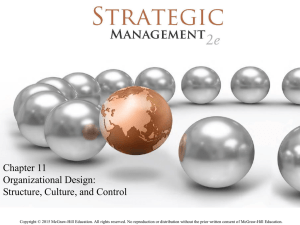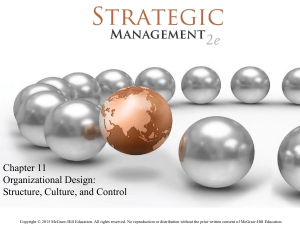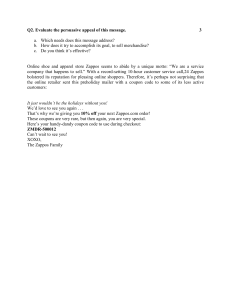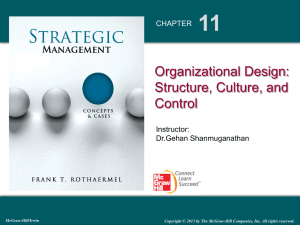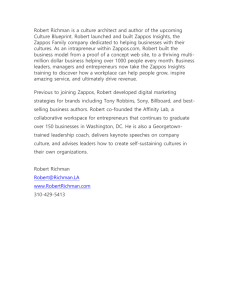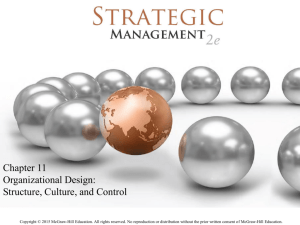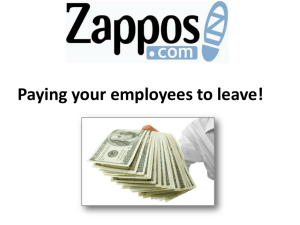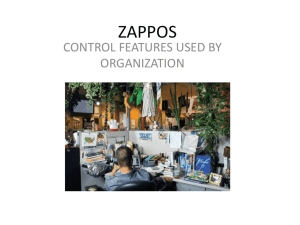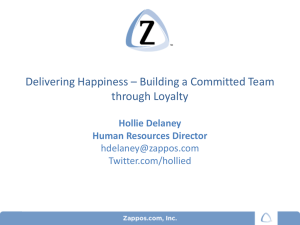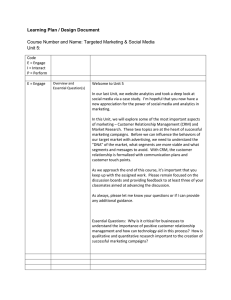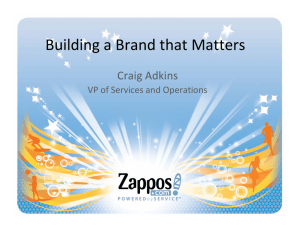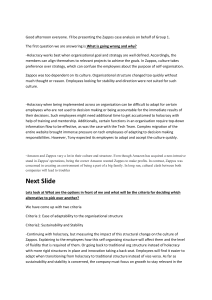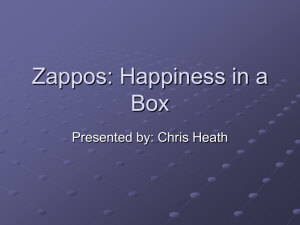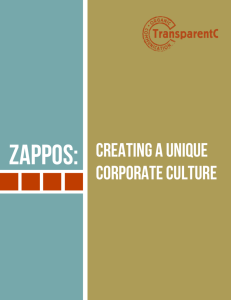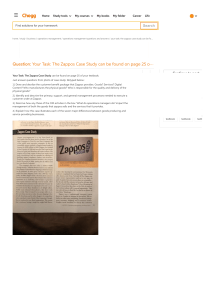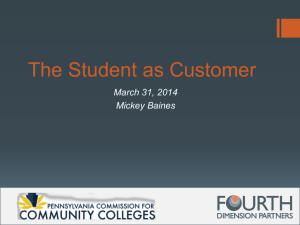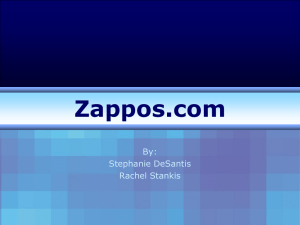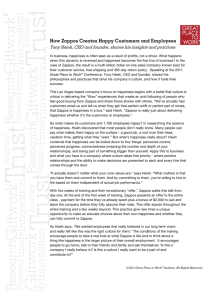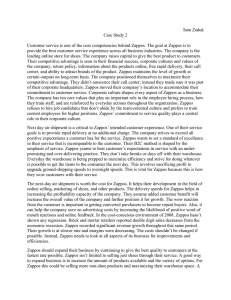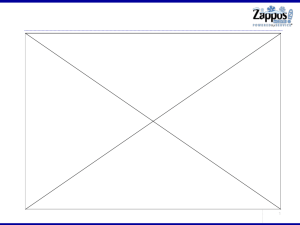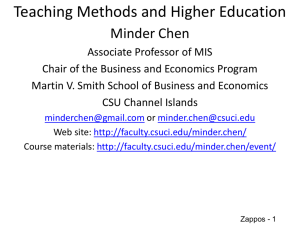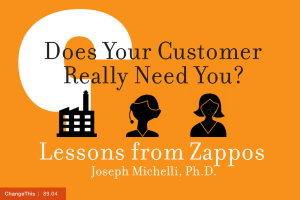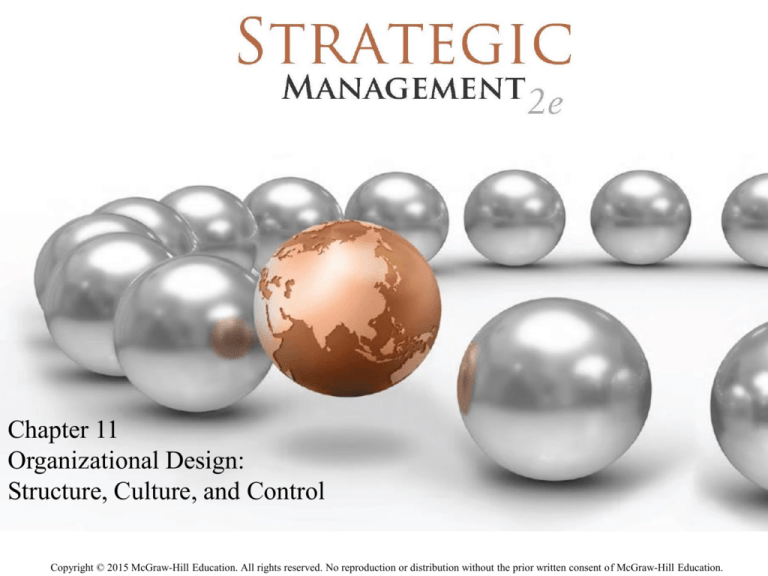
Chapter 11
Organizational Design:
Structure, Culture, and Control
Copyright © 2015 McGraw-Hill Education. All rights reserved. No reproduction or distribution without the prior written consent of McGraw-Hill Education.
11-2
Chapter Outline
11.1 How to Organize for Competitive Advantage
11.2 Matching Strategy and Structure
11.3 Organizational Culture: Values, Norms, and Artifacts
11.4 Strategic Control-and-Reward Systems
11.5 Implications for the Strategist
11-3
ChapterCase 11
Zappos: Designed to Deliver Happiness
Exceptional Customer Service → Core Competency
• All customer service is done in-house.
• No scripts or timed calls in the call centers
• Keep its own stocked products… no drop-shipment
Flat Organizational Structure = Flexibility
• Job rotation = widely trained talent
Internal promotion opportunities
Reorganized into 10 business units to manage growth
An independent subsidiary of Amazon since 2009
Photo courtesy of Zappos and the Delivering Happiness Team
11-4
11.1 How to Organize for
Competitive Advantage
Organizational design
• Goal is to translate strategies into realized ones
• Structure, processes, and procedures
Implementation… the “graveyard of strategy”
• Yahoo’s founder Jerry Yang was fired.
poor implementation….. lost 75% of market value
Structure follows strategies. (Alfred Chandler)
• Therefore structure must be flexible.
11-5
Exhibit 11.2
Organizational Inertia and the
Failure of Established Firms When External or
Internal Environments Shift
11-6
The Key Elements of
Organizational Structure
Organizational structure:
• Defines how jobs and tasks are divided and integrated
• Delineates the reporting relationships up and down the
hierarchy
• Defines formal communication channels
• Prescribes how individuals and teams coordinate their work
efforts
The key building blocks of structure are:
specialization, formalization, centralization, and
hierarchy.
11-7
Strategy Highlight 11.1
W. L. Gore & Associates: Informality and Innovation
1958 – Founder Bill Gore articulated four core values
that still guide the company today.
W. L. Gore is an informal and decentralized
organization.
• Empowered employees (no job titles, no job descriptions,
informal team organization, soft reporting lines)
• Face-to-face communication
• All associates are shareholders of the company.
Gore: one of the largest privately held firms
• 10,000 employees and over $2.5 billion in revenues
11-8
Assembling the Pieces: Mechanistic
vs. Organic Organizations
Organic organizations
•
•
•
•
Low degree of specialization and formalization
Flat structure
Decentralized decision making
Uses virtual teams due to information technology
Examples: Zappos and W. L. Gore
Mechanistic organizations
• High degree of specialization and formalization
• Tall hierarchy
• Centralized decision making
Example: McDonald’s−Hamburger U in Chicago & China
11-9
11.2 Matching Strategy and
Structure
Simple Structure
Functional Structure
Multidivisional Structure
Matrix Structure
11-10
Exhibit 11.4
Changing Organizational
Structures and Increasing Complexity as Firms Grow
11-11
Functional Structure
Groups of employees with distinct functional areas
The areas of expertise correspond to distinct stages in
the company’s value chain activities.
• Examples: College of Business Administration, strong CEO
organizations
Recommended with limited diversification
• Matches well with business-level strategy
Cost leadership
Mechanistic organization
Differentiation
Organic organization
Integration strategy
Ambidextrous organization
11-12
Strategy Highlight 11.2
USA Today: Leveraging Ambidextrous Organizational Design
USA Today: one of the biggest print circulations in U.S.
Used an ambidextrous organizational design to
successfully reintegrate its independent online unit
USA Today.com created as an in-house startup
• Has large cultural differences and is separated from the print
biz
• Starved for corporate resources despite initial success
USA Today and USA Today.com then integrated,
• Leveraging synergies and changing senior team incentives.
• General managers key to finding synergies.
11-13
Exhibit 11.7 Typical Multidivisional
(M-Form) Structure
(Note that SBU 2 uses a functional structure and SBU
4 uses a matrix structure.)
11-14
Multidivisional Structure
(cont’d)
Use with various corporate strategies
Related diversification
• Co-opetition among SBUs
• Transfer core competences across SBUs
• Centralized decision making
Unrelated diversification
• Decentralized decision making
• Competing for resources
11-15
Exhibit 11.8 Matching CorporateLevel Strategy and Structure
11-16
Matrix Structure
A combination of functional and M-form structure
•
•
•
•
Creation of dual line of authority and reporting lines
Each SBU receives support both horizontally and vertically
Very versatile
Enhanced learning from different SBUs
Shortcomings
• Difficult to implement
• Complexity increases when expanding, especially globally
• Unclear reporting structure causes confusion and delays
11-17
Exhibit 11.9 Typical Matrix Structure
with Geographic and SBU Divisions
11-18
Evolutionary/Tech Structures
Network Form – structure where firm focuses
on 1-2 primary Value Chain Activities and
outsources all others to create a best-in-class
firm, or structure of autonomous work teams
operating independently under firm umbrella
Virtual Form – Firm as a nexus of contracts
and network-managed relationships, often no
physical form or property.
11-19
11.3 Organizational Culture:
Values, Norms, and Artifacts
Organizational culture
•
•
•
•
Collectively shared values and norms
Value: what is considered important
Norms: appropriate employee behaviors and attitudes
Artifacts: expression of culture in items such as physical
design, stories, and celebrations
Socialization
• Internalize organization’s value and norms through
interactions
Think of Zappos’ core values
11-20
Where Do Organizational
Cultures Come From?
Founder imprinting
• Founders defined and shaped the culture
Apple (Steve Jobs)
Microsoft (Bill Gates)
Harpo Productions (Oprah Winfrey)
Walmart’s “low cost” culture by Sam Walton
Recruit people that fit the culture
• Zappos pays new hires if they want to…. quit!
11-21
Organizational Culture and
Competitive Advantage
Culture must be valuable, rare, inimitable, and nonsubstitutable (VRIO see Ch. 4).
• Protected by causal ambiguity and social complexity
Culture affects behavior and firm performance:
• Southwest Airlines (SWA)
SWA’s unique culture helps it keep costs low by turning around its
planes faster, thus keeping them flying longer hours.
• Zappos
Zappos’ “WOW” customer experience is accomplished by “going
the extra mile.” Long-term superior experience does increase the
company’s perceived value and its economic value creation.
11-22
11.4 Strategic Control-and-Reward
Systems
Internal governance mechanisms
• Culture
• Sanctions
Input controls
• Budgets
• Rules and standard operating procedures
Output controls
• Result-oriented
• ROWEs -3M; 15% work on own projects
Not directed from the top
11-23
11.5 Implications for the Strategist
Formulating effective strategies
• Necessary but not sufficient condition
To gain and sustain competitive advantage
Strategy execution is at least as important for success.
•
SWOT helps operationalize strategy implementation.
Strategy implementation requires managers to design
and shape structure, culture, and control mechanisms.
Strategy formulation and implementation
• Iterative and interdependent activities
11-24
ChapterCase 11
Consider This…
• What would you do if a programming error cost
your firm $1.6 million?
• Zappos put their money where their “WOW” is.
• Zappos accidentally capped the price at $49.95 for
all products sold on its subsidiary site at midnight,
and the mistake was not discovered until 6 a.m.
• Consistent with their “WOW” philosophy, Zappos
honored all sales during this time period.
Photo courtesy of Zappos and the Delivering Happiness Team
11-25
11-26

